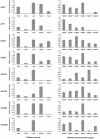Identification and characterization of microRNAs from peanut (Arachis hypogaea L.) by high-throughput sequencing
- PMID: 22110666
- PMCID: PMC3217988
- DOI: 10.1371/journal.pone.0027530
Identification and characterization of microRNAs from peanut (Arachis hypogaea L.) by high-throughput sequencing
Abstract
Background: MicroRNAs (miRNAs) are noncoding RNAs of approximately 21 nt that regulate gene expression in plants post-transcriptionally by endonucleolytic cleavage or translational inhibition. miRNAs play essential roles in numerous developmental and physiological processes and many of them are conserved across species. Extensive studies of miRNAs have been done in a few model plants; however, less is known about the diversity of these regulatory RNAs in peanut (Arachis hypogaea L.), one of the most important oilseed crops cultivated worldwide.
Results: A library of small RNA from peanut was constructed for deep sequencing. In addition to 126 known miRNAs from 33 families, 25 novel peanut miRNAs were identified. The miRNA* sequences of four novel miRNAs were discovered, providing additional evidence for the existence of miRNAs. Twenty of the novel miRNAs were considered to be species-specific because no homolog has been found for other plant species. qRT-PCR was used to analyze the expression of seven miRNAs in different tissues and in seed at different developmental stages and some showed tissue- and/or growth stage-specific expression. Furthermore, potential targets of these putative miRNAs were predicted on the basis of the sequence homology search.
Conclusions: We have identified large numbers of miRNAs and their related target genes through deep sequencing of a small RNA library. This study of the identification and characterization of miRNAs in peanut can initiate further study on peanut miRNA regulation mechanisms, and help toward a greater understanding of the important roles of miRNAs in peanut.
Conflict of interest statement
Figures
Similar articles
-
Deep sequencing identifies novel and conserved microRNAs in peanuts (Arachis hypogaea L.).BMC Plant Biol. 2010 Jan 5;10:3. doi: 10.1186/1471-2229-10-3. BMC Plant Biol. 2010. PMID: 20047695 Free PMC article.
-
Small RNA profiling and degradome analysis reveal regulation of microRNA in peanut embryogenesis and early pod development.BMC Genomics. 2017 Mar 2;18(1):220. doi: 10.1186/s12864-017-3587-8. BMC Genomics. 2017. PMID: 28253861 Free PMC article.
-
Identification of Taxus microRNAs and their targets with high-throughput sequencing and degradome analysis.Physiol Plant. 2012 Dec;146(4):388-403. doi: 10.1111/j.1399-3054.2012.01668.x. Epub 2012 Jul 25. Physiol Plant. 2012. PMID: 22708792
-
MicroRNA profiling: approaches and considerations.Nat Rev Genet. 2012 Apr 18;13(5):358-69. doi: 10.1038/nrg3198. Nat Rev Genet. 2012. PMID: 22510765 Free PMC article. Review.
-
Advances in Point-of-Care Testing of microRNAs Based on Portable Instruments and Visual Detection.Biosensors (Basel). 2023 Jul 20;13(7):747. doi: 10.3390/bios13070747. Biosensors (Basel). 2023. PMID: 37504145 Free PMC article. Review.
Cited by
-
Origin and Evolutionary Dynamics of the miR2119 and ADH1 Regulatory Module in Legumes.Genome Biol Evol. 2020 Dec 6;12(12):2355-2369. doi: 10.1093/gbe/evaa205. Genome Biol Evol. 2020. PMID: 33045056 Free PMC article.
-
Genome-wide identification of salinity responsive HSP70s in common bean.Mol Biol Rep. 2016 Nov;43(11):1251-1266. doi: 10.1007/s11033-016-4057-0. Epub 2016 Aug 24. Mol Biol Rep. 2016. PMID: 27558093
-
The genus Arachis: an excellent resource for studies on differential gene expression for stress tolerance.Front Plant Sci. 2023 Oct 30;14:1275854. doi: 10.3389/fpls.2023.1275854. eCollection 2023. Front Plant Sci. 2023. PMID: 38023864 Free PMC article. Review.
-
Catalog of Erycina pusilla miRNA and categorization of reproductive phase-related miRNAs and their target gene families.Plant Mol Biol. 2013 May;82(1-2):193-204. doi: 10.1007/s11103-013-0055-y. Epub 2013 Apr 11. Plant Mol Biol. 2013. PMID: 23575662
-
High throughput sequencing of two celery varieties small RNAs identifies microRNAs involved in temperature stress response.BMC Genomics. 2014 Mar 27;15:242. doi: 10.1186/1471-2164-15-242. BMC Genomics. 2014. PMID: 24673837 Free PMC article.
References
-
- Lee RC, Feinbaum RL, Ambros V. The C. elegans heterochronic gene lin-4 encodes small RNAs with antisense complementarity to lin-14. Cell. 1993;75:843–854. - PubMed
-
- Griffiths-Jones S. miRBase: the microRNA sequence database. Methods Mol Biol. 2006;342:129–138. - PubMed
-
- Zhang B, Pan X, Cannon CH, Cobb GP, Anderson TA. Conservation and divergence of plant microRNA genes. Plant J. 2006;46:243–259. - PubMed
Publication types
MeSH terms
Substances
LinkOut - more resources
Full Text Sources
Research Materials




